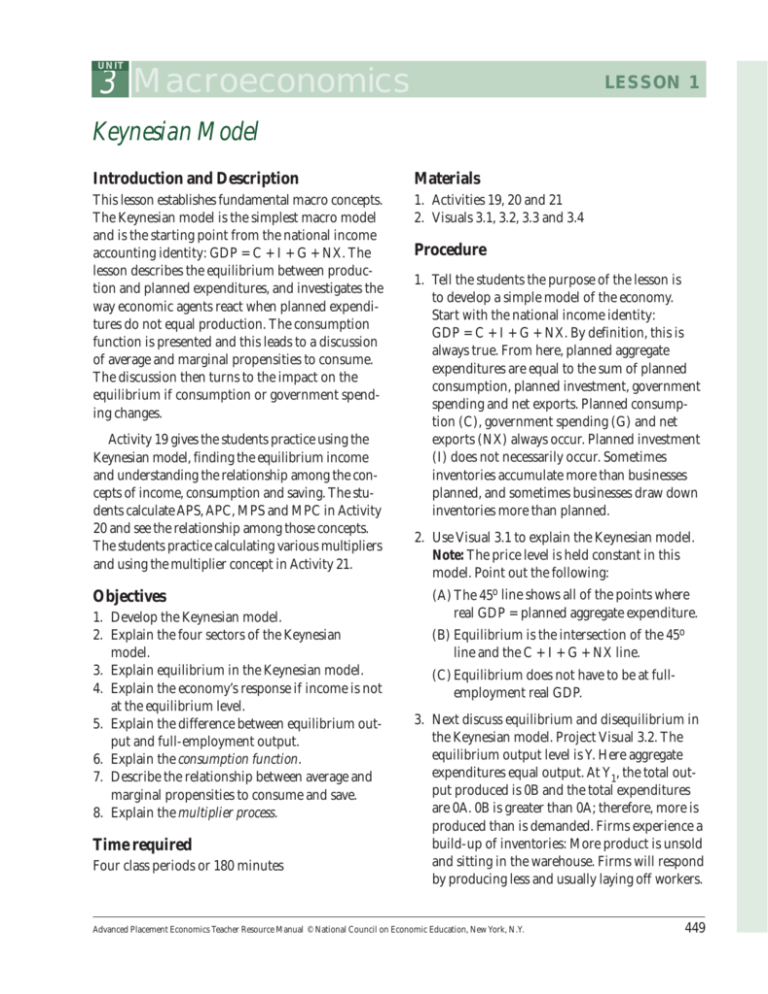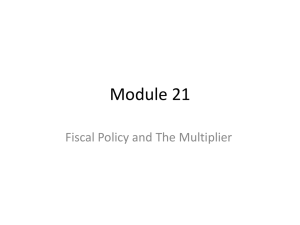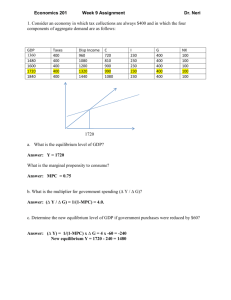lesson 1
advertisement

UNIT 3 Macroeconomics LESSON 1 Keynesian Model Introduction and Description Materials This lesson establishes fundamental macro concepts. The Keynesian model is the simplest macro model and is the starting point from the national income accounting identity: GDP = C + I + G + NX. The lesson describes the equilibrium between production and planned expenditures, and investigates the way economic agents react when planned expenditures do not equal production. The consumption function is presented and this leads to a discussion of average and marginal propensities to consume. The discussion then turns to the impact on the equilibrium if consumption or government spending changes. 1. Activities 19, 20 and 21 2. Visuals 3.1, 3.2, 3.3 and 3.4 Activity 19 gives the students practice using the Keynesian model, finding the equilibrium income and understanding the relationship among the concepts of income, consumption and saving. The students calculate APS, APC, MPS and MPC in Activity 20 and see the relationship among those concepts. The students practice calculating various multipliers and using the multiplier concept in Activity 21. Objectives 1. Develop the Keynesian model. 2. Explain the four sectors of the Keynesian model. 3. Explain equilibrium in the Keynesian model. 4. Explain the economy’s response if income is not at the equilibrium level. 5. Explain the difference between equilibrium output and full-employment output. 6. Explain the consumption function. 7. Describe the relationship between average and marginal propensities to consume and save. 8. Explain the multiplier process. Time required Four class periods or 180 minutes Procedure 1. Tell the students the purpose of the lesson is to develop a simple model of the economy. Start with the national income identity: GDP = C + I + G + NX. By definition, this is always true. From here, planned aggregate expenditures are equal to the sum of planned consumption, planned investment, government spending and net exports. Planned consumption (C), government spending (G) and net exports (NX) always occur. Planned investment (I) does not necessarily occur. Sometimes inventories accumulate more than businesses planned, and sometimes businesses draw down inventories more than planned. 2. Use Visual 3.1 to explain the Keynesian model. Note: The price level is held constant in this model. Point out the following: (A) The 45o line shows all of the points where real GDP = planned aggregate expenditure. (B) Equilibrium is the intersection of the 45o line and the C + I + G + NX line. (C) Equilibrium does not have to be at fullemployment real GDP. 3. Next discuss equilibrium and disequilibrium in the Keynesian model. Project Visual 3.2. The equilibrium output level is Y. Here aggregate expenditures equal output. At Y1, the total output produced is 0B and the total expenditures are 0A. 0B is greater than 0A; therefore, more is produced than is demanded. Firms experience a build-up of inventories: More product is unsold and sitting in the warehouse. Firms will respond by producing less and usually laying off workers. Advanced Placement Economics Teacher Resource Manual © National Council on Economic Education, New York, N.Y. 449 UNIT 3 Macroeconomics The output will decrease and move the economy toward the equilibrium level of output Y. 4. Now draw a vertical line at a level of output below Y. Ask the students to explain what is going on in the economy. More is demanded than is supplied; firms will be experiencing unplanned inventory reduction. Firms will respond by increasing production and employment. The economy will move toward Y. 5. Now look at one component of aggregate expenditures: consumption. Explain that consumption can be represented by the equation C = a + bY, where Y is income or output. The b is the marginal propensity to consume (MPC). It shows the amount by which consumption will increase if income increases by $1. MPC = change in consumption / change in income. 6. Have the students complete Activity 19, and review the answers. 7. In the simplest model, households have only two things they can do with their income: consume or save. Thus, Y = C + S. Use Visual 3.3 to show savings and dissavings. In addition, since households have the choice only to consume or save, the marginal propensity to consume plus the marginal propensity to save must equal 1, or MPC + MPS = 1. 8. Have the students complete Activity 20, and review the answers. 9. Use Visual 3.4 to show what happens if businesses decide to spend more on investment goods. Point out that output goes up. By how much does output rise? Explain the multiplier process to the students. Demonstrate that the result depends on the MPC. LESSON 1 10. Expand on the idea of consumption and make it more realistic by introducing the concept of taxes. The consumption relationship now becomes C = a + b YD, where YD is disposable income. Disposable income = Y–T where T represents taxes. Thus, households have three ways to spend income: consume, save and pay taxes. 11. Note that if the students are good at algebra, you can show them how to find the different multipliers by using the following simple equation system and substituting C = a + b(Y – T) I = I0 G = G0 NX = NX0 Y = C + I + G + NX Here’s how to derive the various multipliers: Substitute the values for C, I, G and NX into the equilibrium condition: Y = a + b (Y – T) + I0 + G0 + NX0 Collecting like terms, we have: Y – bY = a – bT + I0 + G0 + NX0 Solving for Y, we have: a bT I0 + G0 + NX0 Y = _______ – _______ + ________________ (1 – b) (1 – b) (1 – b) Holding T, G and NX constant, a change in I will change Y by ∆Y = (1/[1 – b]) ∆I We then arrive at the investment multiplier: ∆Y = ______ 1 ___ ∆I (1 – b) Likewise we can derive the lump-sum tax multiplier and arrive at ∆Y –b ___ = ______ ∆T (1 – b) 12. Have the students complete Activity 21, and review the answers. 450 Advanced Placement Economics Teacher Resource Manual © National Council on Economic Education, New York, N.Y. UNIT 3 Macroeconomics LESSON 1 ■ ACTIVITY 19 Answer Key Keynesian Equilibrium This activity is designed to give you practice with manipulations of the aggregate expenditure model. It shows you how the expenditure schedule is derived and how it helps to determine the equilibrium level of income. This activity assumes that the price level is constant with the consumer price index or price level having a value of 100. All numbers in Figure 19.1 are in billions of constant dollars. Figure 19.1 Income-Expenditure Schedule Income Consumption Investment Government (Output) Spending Spending Spending Total Spending (Aggregate Expenditure) $2,400 $2,500 $300 $100 $2,900 2,600 2,600 300 100 3,000 2,800 2,700 300 100 3,100 3,000 2,800 300 100 3,200 3,200 2,900 300 100 3,300 3,400 3,000 300 100 3,400 3,600 3,100 300 100 3,500 3,800 3,200 300 100 3,600 1. Use the data on consumption spending and income to draw the consumption function on the graph in Figure 19.2. Label the function C. 2. Using the consumption function you have just drawn and the data on investment and government spending, draw the aggregate expenditure schedule on the same graph. Label it AE (C + I + G). What is the difference between the aggregate expenditure schedule and the consumption function? $400: the sum of government spending (G) and investment spending (I) 3. Now draw a line representing all the points at which total spending and income could be equal. Label this the 45° line. 4. The 45° line represents all the points that could be the equilibrium level of total spending. Now circle the one point that is the equilibrium level of total spending. What is the equilibrium level of total spending on your graph? $3,400 billion Advanced Placement Economics Teacher Resource Manual © National Council on Economic Education, New York, N.Y. 451 UNIT 3 Macroeconomics LESSON 1 ■ ACTIVITY 19 Answer Key Figure 19.2 Aggregate Expenditure Model $3,800 AGGREGATE EXPENDITURES (billions of constant dollars) 3,600 AE(C + I + G) 3,400 3,200 C 3,000 2,800 2,600 2,400 2,200 2,000 3,800 3,600 3,400 3,200 3,000 2,800 2,600 2,400 2,200 45˚ $2,000 0 REAL NATIONAL INCOME (output in billions of constant dollars) 5. Based on the data in Figure 19.1, and assuming that the full-employment level of total spending is $3,600 billion, what conclusions can you draw about the equilibrium level of total spending? The equilibrium level of total spending is below the full-employment level of total spending. There is unemployment of resources; the economy is in a recession. 6. Based on the data in Figure 19.1, and assuming that the full-employment level of total spending is $3,200 billion, what conclusions can you draw about the equilibrium level of total spending? The equilibrium level of total spending is above the full-employment level of total spending. 7. If government spending increased by $100 billion, what would be the new equilibrium level of For the increase of $100 billion in government spending, total spending? $3,600 billion . Explain why this occurs. The new equilibrium total spending increased by $200 billion level of total spending is $3,600 billion. The increase in government spending becomes income to other people who in turn spend a portion of the increase in income, etc. The total effect of the $100 billion increase in government spending is an increase in total spending of $200 billion. 452 Advanced Placement Economics Teacher Resource Manual © National Council on Economic Education, New York, N.Y. UNIT 3 Macroeconomics LESSON 1 ■ ACTIVITY 20 Answer Key Practice with APC, APS, MPC and MPS Part A Average Propensities The average propensity to consume (APC) is the ratio of consumption expenditures (C) to disposable income (DI), or APC = C / DI. The average propensity to save (APS) is the ratio of savings (S) to disposable income, or APS = S / DI. 1. Using the data in Figure 20.1, calculate the APC and APS at each level of disposable income given. The first calculation is completed as an example. Figure 20.1 Average Propensities to Consume and to Save Disposable Income Consumption Saving APC APS $0 $2,000 –$2,000 — — 2,000 3,600 –1,600 1.8 –0.8 4,000 5,200 –1,200 1.30 –0.3 6,000 6,800 –800 1.13 –0.13 8,000 8,400 –400 1.05 –0.05 10,000 10,000 0 1.00 0 12,000 11,600 400 0.97 0.03 2. How can savings be negative? Explain. People are borrowing or reducing their savings to be able to consume at the particular level of income. Part B Marginal Propensities The marginal propensity to consume (MPC) is the change in consumption divided by the change in disposable income. It is a fraction of any change in DI that is spent on consumer goods: MPC = ∆C / ∆DI. The marginal propensity to save (MPS) is the fraction saved of any change in disposable income. The MPS is equal to the change in saving divided by the change in DI: MPS = ∆S / ∆DI. 3. Using the data in Figure 20.2, calculate the MPC and MPS at each level of disposable income. The first calculation is completed as an example. (This is not a typical consumption function. Its purpose is to provide practice in calculating MPC and MPS.) Advanced Placement Economics Teacher Resource Manual © National Council on Economic Education, New York, N.Y. 453 UNIT 3 Macroeconomics LESSON 1 ■ ACTIVITY 20 Answer Key Figure 20.2 Marginal Propensities to Consume and to Save Disposable Income Consumption Saving MPC MPS — — $12,000 $12,100 –$100 13,000 13,000 0 0.90 0.10 14,000 13,800 200 15,000 14,500 500 16,000 15,100 900 17,000 15,600 1,400 0.80 0.70 0.60 0.50 0.20 0.30 0.40 0.50 4. Why must the sum of the MPC and MPS always equal 1? The only choice people have is to consume or to save. Thus an additional dollar in income must result in a change in consumption and/or a change in savings. The sum of the change must be one. Part C Figure 20.3 Changes in APC and MPC as DI Increases Disposable Income Consumption Savings $10,000 $12,000 –$2,000 20,000 21,000 –1,000 30,000 30,000 0 40,000 39,000 1,000 50,000 48,000 2,000 60,000 57,000 3,000 70,000 66,000 4,000 APC APS MPC MPS 1.20 1.05 1.00 0.975 0.96 0.95 0.94 –0.20 –0.05 0 0.025 0.04 0.05 0.06 — — 0.90 0.90 0.90 0.90 0.90 0.90 0.10 0.10 0.10 0.10 0.10 0.10 5. Complete Figure 20.3, and answer the questions based on the completed table. 6. What is the APC at a DI level of $10,000? 7. What happens to the APC as DI rises? 1.20 At $20,000? 1.05 It decreases. 8. What is the MPC as DI goes from $50,000 to $60,000? 0.90 From $60,000 to $70,000? 9. What happens to MPC as income rises? It remains constant. as income rises? It remains constant. 0.90 What happens to MPS 10. What is the conceptual difference between APC and MPC? The APC measures the average consumption at any level of disposable income. The MPC measures what proportion of each additional dollar of income consumers will spend. 454 Advanced Placement Economics Teacher Resource Manual © National Council on Economic Education, New York, N.Y. UNIT 3 Macroeconomics Answer Key LESSON 1 ■ ACTIVITY 21 The Magic of the Multiplier The people in Econoland live on an isolated island. One year a stranger arrived and built a factory to make seashell charms. The factory is considered an investment on Econoland. If the marginal propensity to consume on the island were 75 percent, or 0.75, this would mean that Econoland residents would consume or spend 75 percent of any change in income and save 25 percent of any change in income. The additional spending would generate additional income and eventually a multiple increase in income. This is called the multiplier effect. When they heard about this multiplier effect, the islanders were thrilled about the new factory because they liked the idea of additional income. The residents of Econoland wanted to know what would eventually happen to the levels of GDP, consumption and saving on the island as the new spending worked its way through the economy. Luckily there was a retired university economist who had settled on Econoland who offered a brief statement of the multiplier. “It’s simple,” he said: “One person’s spending becomes another person’s income.” The economist began a numerical example. “This shows the process,” he said. The rounds refer to the new spending moving from resident to resident. He stopped his example at four rounds and added the rest of the rounds to cover all Econoland’s citizens. Figure 21.1 Changes in Econoland’s GDP, Consumption and Saving Round Income (GDP) Consumption Spending Saving Round 1 $1,000 0.75 of $1,000 = $750 0.25 of $1,000 = $250 Round 2 One person’s spending becoming another person’s income: $750 0.75 of $750 = $562.50 0.25 of $750 = $187.50 The next person’s spending becoming another person’s income: $562.50 0.75 of $562.50 = $421.88 0.25 of $562.50 = $140.62 The next person’s spending becoming another person’s income: $421.88 0.75 of $421.88 = $316.41 0.25 of $421.88 = $105.47 Round 3 Round 4 Rounds continue All rounds • • • • • • • • • Final outcome for income (GDP) 1 / (1 – 0.75) x $1,000 = 4 x $1,000 = $4,000 Final outcome for consumption spending 0.75 of $4,000 = $3,000 Advanced Placement Economics Teacher Resource Manual © National Council on Economic Education, New York, N.Y. Final outcome for saving 0.25 of $4,000 = $1,000 455 UNIT 3 Macroeconomics LESSON 1 ■ ACTIVITY 21 Answer Key The retired economist then summarized the multiplier effect for the assembled crowd of Econolanders. “This shows us that the factory is an investment that has a multiplied effect on our GDP. In this case, the multiplier is 4.” He added, “It appears to be magic, but it is simply that one person’s spending becomes another person’s income.” There were some nods of agreement but also many puzzled looks, so the old professor asked the citizens a series of questions. Answer these questions as if you were an Econolander. 1. Would the multiplier be larger or smaller if you saved more of your additional income? Smaller 2. What do you think would happen if all Econolanders saved all of the change in their incomes? There would not be any change in output from consumption. 3. What would happen if you spent all of the change in your income? There would be an infinite change in output from consumption. The professor broke out into a smile as the answers all came out correct. The economist reminded the islanders about the multiplied effect on GDP that a new road around the island would have. That new bridge built by the island government over the lagoon would also have a multiplied effect on GDP. This time there were many more nods of approval and understanding. The economist also indicated that if the government of Econoland lowered taxes, the citizens would have more income to spend, which would cause a multiplier effect. He said there was another side to this: If the taxes were raised, there would be a multiplier effect, which would decrease income and GDP by a multiple amount. The King of Econoland commissioned the old economist to write a simple explanation about multipliers so all the citizens of Econoland would understand. He told the old economist: “If you succeed in helping all citizens understand the multiplier in simple terms, you will be rewarded. If not, you will be banished from the island.” The economist started banging away on an old rusting typewriter since he did not want to be banished from this island paradise. The result follows: 456 Advanced Placement Economics Teacher Resource Manual © National Council on Economic Education, New York, N.Y. UNIT 3 Macroeconomics LESSON 1 ■ ACTIVITY 21 Answer Key The Professor’s Treatise on Multipliers MULTIPLIER FORMULAS AND TERMS Marginal propensity to consume (MPC) = change in consumption divided by change in income Marginal propensity to save (MPS) = change in saving divided by change in income Investment Multiplier = 1 / (1 – MPC) or simply 1 / MPS How to use the investment multiplier: change in GDP = change in investment times investment multiplier When to use the investment multiplier: when there is a change in investment such as a new factory or new equipment Government Spending Multiplier = 1 / (1 – MPC) or simply 1 / MPS How to use the government spending multiplier: change in GDP = change in government spending times government spending multiplier When to use the government spending multiplier: when there is a change in government spending such as a new road or bridge Tax Multiplier = – MPC / (1 – MPC) = – MPC / MPS How to use the tax multiplier: change in GDP = change in taxes times tax multiplier When to use the tax multiplier: when there is a change in lump-sum taxes. Remember that the tax multiplier has a negative sign. Figure 21.2 Multiplier Table (Derived from using the formulas above) MPC 0.90 0.80 0.75 0.60 0.50 Investment Multiplier 10.0 5.0 4.0 2.5 2.0 Government Spending Multiplier 10.0 5.0 4.0 2.5 2.0 Tax Multiplier –9.0 –4.0 –3.0 –1.5 –1.0 “ALWAYS” RULES (A surefire way to remember multipliers) ■ ■ ■ The investment multiplier is always equal to the same value as the government spending multiplier. The investment and government spending multipliers are always positive. The tax multiplier is always negative. Advanced Placement Economics Teacher Resource Manual © National Council on Economic Education, New York, N.Y. 457 UNIT 3 Macroeconomics LESSON 1 ■ ACTIVITY 21 Answer Key The King took the treatise and had it printed for every islander. He then ordered the old professor to make up a series of questions to see if the subjects understood the multiplier. Answer the questions on the professor’s test. The Econoland Test 1. What is the value of the tax multiplier if the MPC is 0.80? –4 2. What is the value of the government spending multiplier if the MPC is 0.67? 3. What is the tax multiplier if the MPS is 0.25? 3 –3 4. How could the multiplier be used to explain wide swings in income (which could be called business cycles) in Econoland? Small changes in expenditure are magnified by the multiplier effect. 5. The numerical value for the investment and government spending multiplier increases as the (A) value of the marginal propensity to save decreases. (B) value of the average propensity to consume increases. (C) value of the marginal propensity to consume decreases. (D) value of the marginal propensity to save increases. (E) value of the average propensity to consume decreases. 6. If the government spending multiplier is 5 in Econoland, the value of the tax multiplier must be (A) 5 (B) 4 (C) 1 (D) – 4 (E) –5 458 Advanced Placement Economics Teacher Resource Manual © National Council on Economic Education, New York, N.Y. UNIT 3 Macroeconomics LESSON 1 ■ ACTIVITY 21 Answer Key Econoland has the following values for income and consumption. Use this data to answer questions 7, 8 and 9. Income 100 200 300 400 500 600 Consumption 150 225 300 375 450 525 7. The government spending multiplier in Econoland is (A) 3 (B) 4 (C) 5 (D) 10 (E) 30 8. If there is an increase in taxes of $200 in Econoland, the decrease in GDP will be (A) $100 (B) $200 (C) $400 (D) $600 (E) $800 9. If there is an increase in government spending of $100 and an increase in taxes of $100 in Econoland, then the change in GDP will be (A) $50 (B) $100 (C) $200 (D) –$100 (E) –$200 10. Why do the people of Econoland need to understand multipliers? Understanding multipliers allows people to understand the impact of fiscal policy and changes in autonomous components of consumption, investment and government spending on total income. Advanced Placement Economics Teacher Resource Manual © National Council on Economic Education, New York, N.Y. 459









